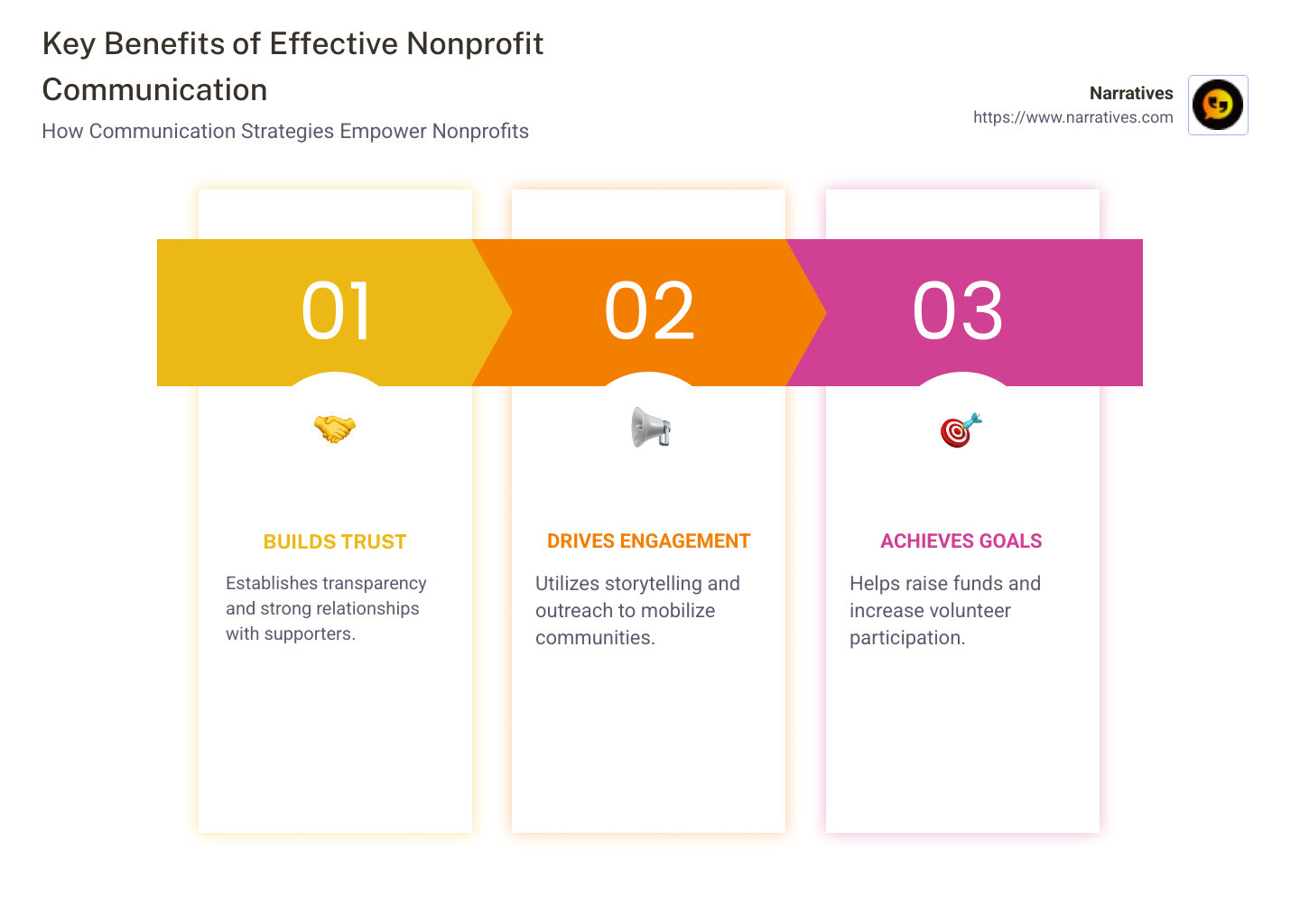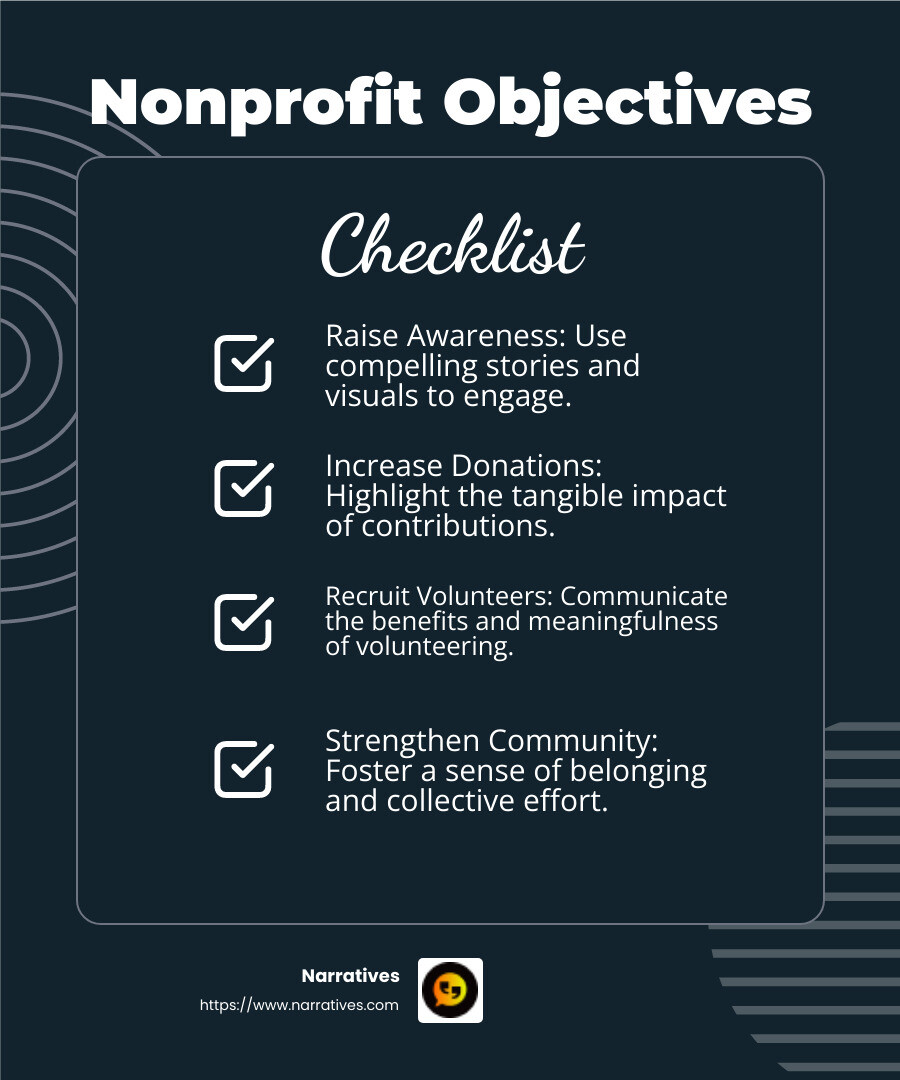Unlocking the Power of Nonprofit Communication: A How-To Guide

Nonprofit communication strategies are critical to the success of any organization seeking to make a difference. Effective communication not only improves visibility but also strengthens relationships with donors, recruits valuable volunteers, and spreads awareness for important causes.
- Build Trust: Strong communication creates transparency and trust between a nonprofit and its supporters.
- Drive Engagement: Engaging storytelling and well-timed outreach can mobilize communities to take action.
- Achieve Goals: Whether it's raising funds or increasing volunteer participation, strategic communication can lead nonprofits to their goals.
In today's world, mastering nonprofit communication is more vital than ever. By crafting clear, compelling messages custom to specific audiences, organizations can outperform their engagement and fundraising targets, truly amplifying their missions.

Basic Nonprofit communication strategies vocab:
Understanding Nonprofit Communication Strategies
To open up the power of nonprofit communication strategies, you need to start with a clear understanding of your objectives. Objectives guide your entire communication plan and set the stage for success. Here’s how you can define and leverage these key elements:
Define Objectives
First, ask yourself: What do we want to achieve? Your objectives might include raising awareness, increasing donations, or recruiting volunteers. Think of objectives as your roadmap—without them, it's easy to get lost.
- Earning Donations: Highlight the impact of contributions. Make donors feel like they are part of something bigger.
- Recruiting Volunteers: Clearly communicate the benefits and meaningfulness of volunteer work.
- Spreading Awareness: Use eye-catching imagery and compelling stories to grab attention.

Know Your Target Audience
Understanding your audience is crucial. Who are they? What do they care about? Tailor your messages to resonate with their interests and values.
- Create Personas: Develop detailed profiles of your ideal supporters. Consider factors like age, location, and interests.
- Engage Personally: People give to causes they feel connected to. Make your communication personal and relatable.
The Power of Storytelling
Storytelling is a powerful tool in your communication arsenal. It’s not just about sharing facts; it’s about creating an emotional connection.
- Emotional Impact: Stories stick with people. They make your mission memorable and relatable.
- Visual and Verbal: Use both words and visuals to tell your story. A great example is the March of Dimes, which effectively shares family stories through visuals and words.

By defining clear objectives, understanding your audience, and using the power of storytelling, your nonprofit can create communication strategies that not only inform but also inspire action. This foundation is essential as you move forward to build an effective communication strategy that truly resonates with your audience.
Building an Effective Nonprofit Communication Strategy
Creating a successful nonprofit communication strategy involves setting clear goals, crafting a strong identity, and ensuring your messaging is clear and consistent. Let’s break down these elements.
Set Goals
The first step in building your strategy is to set specific, actionable goals. Goals help you measure success and stay focused. Here are some examples:
- Establish Branding and Story: Define who you are and what you stand for. This will be the backbone of your communication efforts.
- Increase Financial Support: Aim for a specific percentage increase in donations over a set period. For example, the Pars Equality Center focuses on empowering Persian-speaking immigrants and aims to increase donations by 20% annually to expand their services.
- Engage with Larger Audiences: Set targets for growing your newsletter subscribers or social media followers.
Attach a timeframe to each goal and assign responsibility to team members. Regularly review these goals to ensure they remain relevant and achievable.
Create Identity
Your nonprofit’s identity is how people perceive you. It’s crucial to communicate your vision, mission, and values clearly. Here’s how to create and communicate your identity:
- Vision and Mission Statements: Keep these statements clear and concise. They should tell people exactly what you aim to achieve and why.
- Consistent Branding: Use the same colors, fonts, and logos across all platforms to create a recognizable brand.
- Storytelling: Share stories that reflect your mission. For instance, an animal shelter might share heartwarming adoption stories to highlight their impact.
Clear Messaging
Your messaging should be straightforward and compelling. It should encourage your audience to take action, whether it’s donating, volunteering, or spreading the word.
- Value Proposition: Clearly articulate how your organization meets the needs of your audience. For example, Wonder Ink provides accessible religious course materials, making it easy for parents and church leaders to engage children.
- Call to Action (CTA): Every piece of communication should include a clear CTA. Whether it’s “Donate Now” or “Join Us Today,” make sure it’s easy for your audience to understand what you want them to do.
- Transparency: Be open about your operations and impact. Transparency builds trust and accountability.
By setting clear goals, creating a strong identity, and ensuring your messaging is clear, you lay a solid foundation for an effective nonprofit communication strategy. This approach not only informs but inspires action, helping your organization thrive.
Next, we’ll explore the key components of nonprofit communication, diving into content creation, choosing the right channels, and maintaining consistency.
Key Components of Nonprofit Communication
The effectiveness of nonprofit communication strategies hinges on three essential components: content creation, choosing the right channels, and maintaining consistency. Let's explore each of these elements.
Content Creation
Content is the heart of your communication strategy. It tells your story, shares your mission, and engages your audience. Here's how to create impactful content:
Variety is Key: Use a mix of blog articles, videos, interviews, social media posts, and infographics to reach different audiences. For instance, a well-crafted video showcasing a success story can be more compelling than text alone.
Storytelling: Integrate storytelling to make your message memorable. Studies show that 55% of people remember stories over facts. Share stories that highlight your nonprofit's impact, like how a donation changed someone's life.
SEO and Shareability: Optimize your content for search engines to increase visibility. Ensure your content is shareable to reach a broader audience. This not only boosts engagement but can also drive more traffic to your site.
Appropriate Channels
Choosing the right channels to distribute your content is crucial. Each platform has its strengths and caters to different demographics:
Social Media: Platforms like Facebook, Twitter, and Instagram are excellent for engaging with a wide audience. Use them to share updates, success stories, and calls to action. Tailor your content to fit the platform's style and audience.
Email Marketing: Email allows for direct communication with supporters. It's personal and has a high return on investment (ROI). Regular newsletters can keep your audience informed and engaged.
Direct Mail: While digital channels are popular, don't overlook traditional methods like direct mail. They can be particularly effective for reaching older demographics who may not be as active online.
Evaluate each channel for its effectiveness in reaching your target audience and achieving your communication goals.
Consistency
Consistency is the thread that ties your communication efforts together. It builds trust and keeps your audience engaged:
Regular Updates: Keep your audience informed with regular updates about your activities, goals, and achievements. This shows transparency and keeps supporters connected to your mission.
Unified Branding: Use consistent branding across all platforms. This includes colors, logos, and tone of voice. A unified brand helps create a recognizable and trustworthy image.
Engagement Rhythm: Establish a rhythm for your communications. Whether it’s weekly newsletters or daily social media posts, consistency helps maintain audience interest and engagement.
By focusing on these key components—content creation, appropriate channels, and consistency—you can improve your nonprofit communication strategy, ensuring your message resonates with your audience and drives action.
Next, we’ll dig into nonprofit communication strategies for engagement, exploring how to leverage social media, email campaigns, and donor retention.
Nonprofit Communication Strategies for Engagement
Engaging your audience is crucial for the success of any nonprofit. Let's explore how nonprofit communication strategies can harness the power of social media, email campaigns, and donor retention to maximize engagement.
Social Media
Social media is a powerful tool for nonprofits. It allows you to connect with a vast audience, share your mission, and drive action. Here’s how to make the most of it:
Visual Content: People love visuals. Share photos, videos, and infographics that tell your story. For example, the ALS Association's Ice Bucket Challenge went viral by using engaging videos that encouraged participation and sharing.
Regular Posting: Keep your profiles active. Post regularly to stay on your audience's radar. Use tools like TrueSocialMetrics to find the best times to post for maximum engagement.
Interaction: Engage with your followers. Reply to comments, ask questions, and encourage discussions. This builds a community around your cause and keeps people interested.
Email Campaigns
Email campaigns are a direct way to communicate with your supporters. They’re personal, cost-effective, and have a high return on investment. Here’s how to leverage them:
Segmentation: Tailor your messages by segmenting your audience. Send personalized emails based on donor history, interests, or location. This makes your communication more relevant and effective.
Compelling Content: Use storytelling to make your emails engaging. Share success stories or impactful updates. 55% of people are more likely to remember a story than just facts.
Call to Action: Every email should have a clear call to action. Whether it’s donating, volunteering, or sharing your message, guide your readers on what to do next.
Donor Retention
Keeping your donors engaged is as important as acquiring new ones. Here’s how to ensure they stay committed to your cause:
Regular Updates: Keep donors informed about how their contributions are making a difference. Send regular updates and thank you notes to show appreciation.
Exclusive Content: Offer donors something special, like behind-the-scenes content or early access to events. This makes them feel valued and part of your nonprofit’s journey.
Feedback and Surveys: Ask for feedback to show you value their opinion. Use surveys to understand what they care about and tailor your strategies accordingly.
By effectively using social media, crafting engaging email campaigns, and focusing on donor retention, nonprofits can strengthen their communication strategies and build lasting relationships with their supporters.
Next, we’ll explore how to measure and improve communication efforts using data analysis, feedback, and metrics.
Measuring and Improving Communication Efforts
To truly open up the potential of nonprofit communication strategies, measure and refine them continually. Here's how data analysis, feedback, and metrics play a crucial role in this process.
Data Analysis
Data is your friend. By analyzing the data from your communication efforts, you can uncover what’s working and what’s not. For instance, tracking metrics like email open rates or social media engagement can reveal which messages resonate best with your audience.
Identify Trends: Look for patterns in your data. Did a particular campaign outperform others? Understanding why can help replicate success in future efforts.
Set Benchmarks: Establish benchmarks to compare your performance over time. This helps in setting realistic goals and measuring progress.
Feedback
Feedback is a gift. It provides insights straight from your audience, allowing you to adjust your strategies to better meet their needs.
Surveys and Polls: Use tools like SurveyMonkey to gather feedback. Ask your supporters what they think about your communications. This direct input is invaluable for making meaningful improvements.
Event Conversations: Engage in conversations at events. Personal interactions can uncover insights that data alone might miss.
Metrics
Metrics are the backbone of measuring success. They help quantify the impact of your communication efforts.
Engagement Metrics: Track likes, shares, and comments on social media posts. These indicate how well your content is connecting with your audience.
Conversion Rates: Measure how many of your communication efforts lead to desired actions, like donations or event sign-ups.
Return on Investment (ROI): Calculate the ROI of your campaigns. This helps ensure that your resources are being used effectively.
By embracing data analysis, actively seeking feedback, and monitoring key metrics, nonprofits can continuously refine their communication strategies. This ongoing process not only improves engagement but also maximizes the impact of limited resources, ultimately driving your mission forward.
Up next, we’ll tackle some frequently asked questions about nonprofit communication strategies to further improve your understanding.
Frequently Asked Questions about Nonprofit Communication Strategies
What are the main goals of nonprofit communication?
The main goals of nonprofit communication are crucial for the success and sustainability of any organization. Here are the key objectives:
Earning Donations: Fundraising is often the lifeblood of nonprofits. Effective communication emphasizes the impact of donations, encouraging supporters to contribute.
Recruiting Volunteers: Volunteers are essential, especially for nonprofits with tight budgets. Communication should highlight the benefits and impact of volunteering.
Spreading Awareness: Raising awareness about your cause helps attract more supporters and drive change. Use attention-grabbing stories or statistics to make your message memorable.
Reaching Beneficiaries: If your organization can serve more people, make sure your communication efforts clearly explain your services and their benefits.
Each goal shapes your communication strategy, influencing everything from the content you create to the platforms you use.
How can storytelling improve nonprofit communication?
Storytelling is a powerful tool for nonprofit communication strategies. Here's why:
Emotional Connection: Stories engage emotions, making your message more memorable. Research shows that 55% of people remember stories over facts.
Mission Clarity: A well-told story can clearly convey your organization's mission and impact, helping supporters understand and connect with your cause.
Engagement Boost: Stories are more likely to be shared, increasing your reach. They can turn supporters into advocates who spread your message further.
For example, sharing a beneficiary's journey or a volunteer's experience can highlight your nonprofit's impact in a relatable way.
What channels are most effective for nonprofit communication?
Choosing the right channels is vital for making your nonprofit communication efforts effective. Here are some popular options:
Email: Still a top tool for nonprofits, email allows for personalized communication and can drive donations and engagement.
Social Media: Platforms like Facebook, Twitter, and YouTube are growing fast. They offer opportunities for storytelling and real-time interaction with supporters.
Direct Mail: While traditional, direct mail can be effective for reaching older audiences who prefer tangible communication.
Google Ads: Utilizing programs like Google Ad Grants can expand your reach with up to $10,000 in free monthly ad credits.
Each channel has its strengths, and the key is to use a mix that aligns with your audience's preferences and your communication goals.
Next, we'll explore how Narratives uses digital storytelling to make a community impact.
Conclusion
In nonprofits, effective communication is the bridge between your mission and the community you aim to impact. At Narratives, we believe in the transformative power of digital storytelling to amplify these efforts. Our approach focuses on elevating underrepresented voices and crafting emotionally resonant content that not only tells your story but inspires action.
Narratives is more than just a digital storytelling partner. We are committed to helping nonprofits create meaningful connections with their audience. By focusing on community-driven storytelling, we ensure that your organization's impact stories are shared in a way that builds trust and increases visibility.
How Digital Storytelling Makes a Difference
Engagement and Trust: Digital storytelling allows nonprofits to engage their audience on a deeper level. By sharing real stories from the communities you serve, you build trust and foster a genuine connection with your supporters.
Increased Visibility: High-quality multimedia content can significantly boost your organization's visibility. Whether it's through videos, images, or written narratives, compelling content is more likely to be shared, expanding your reach.
Inspiring Action: Stories have the power to move people. By highlighting your nonprofit's impact through storytelling, you can inspire your audience to take action—be it donating, volunteering, or advocating for your cause.
At Narratives, our mission is to support nonprofits in their journey to make a community impact. We provide the tools and expertise needed to open up the full potential of your nonprofit communication strategies.
Ready to lift your nonprofit's storytelling? Learn more about how Narratives can help and join us in creating a better, more connected world.


